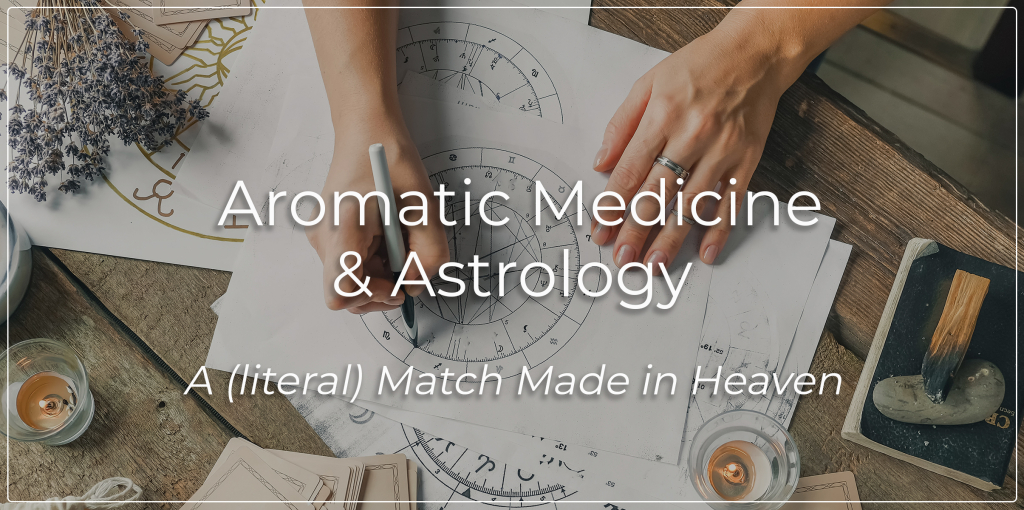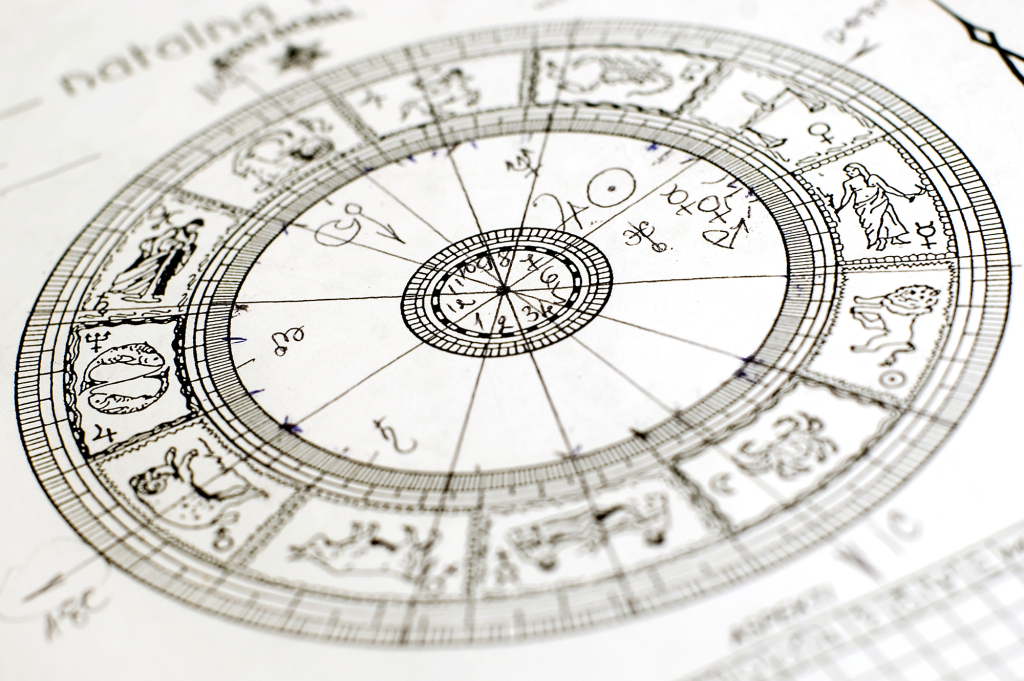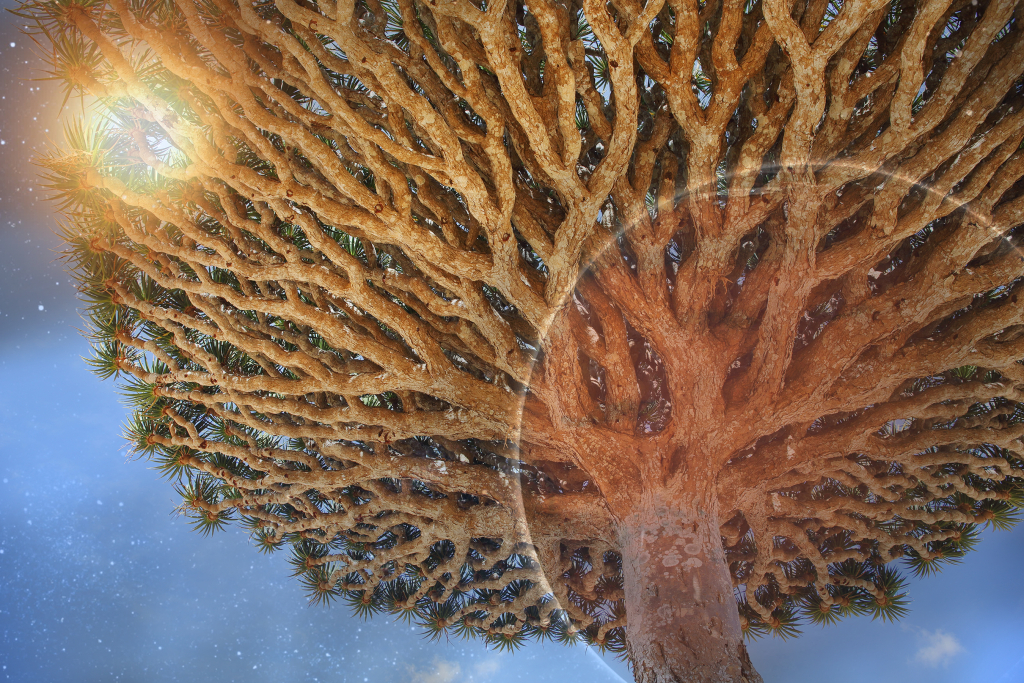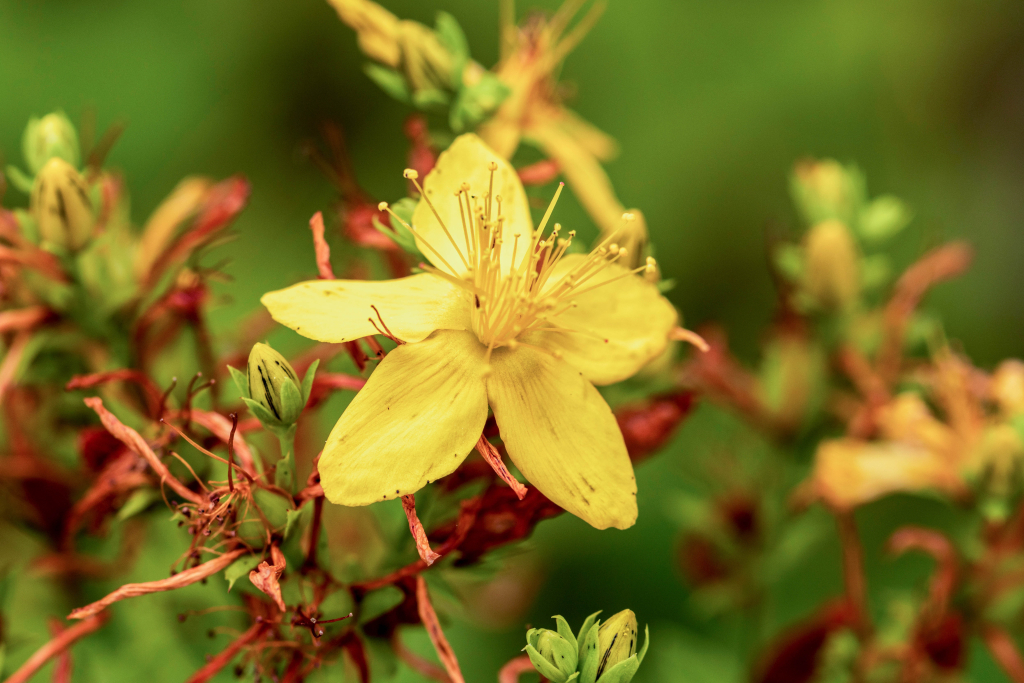
Incorporating astrology into herbal medicine or aromatherapy can be an incredible way to be more holistic with your practice. Astrology shows us how to understand the archetypal forces of nature, which influence both people and medicinal plants. Through this understanding, we’re offered a more precise and thorough approach for bringing plants and people together.
Historically it was important for a physician to be well versed in astrology in order to classify and understand plants, classify disease and provide therapeutics, and understand bodily constitutions. It has been used throughout history as a way to better understand the whole person.
In the astrological birth chart, or natal chart, a reflection of a person is shown. The birth chart is a time-capture of exactly what was happening in the sky, above and below the horizon, at the moment, season, and place a person was born.
The astrological chart is not only a way to see someone’s personality tendencies, it can also be an important diagnostics tool that has unfortunately been oversimplified by pop culture throughout time. Because of this, its essence can be greatly misunderstood. But the more you explore astrology in depth, it reveals as an incredibly valuable means to learn about yourself, as well as deepen your practice of medicine, your understanding of plants and how to heal with them.

The Holistic Nature of Astrological
Aromatherapy & Herbalism
Using the birth chart as a resource can help you get more specific with your herbal selections and be more holistic with medicinal preparations. It allows you to go beyond giving a ‘use this-for-that’ remedy, focused on just treating a certain symptom. Seeing both the individual and plants as a whole offers the opportunity for a much more targeted approach to your practice.
It is less about which remedy you give, and more about how and why you give a remedy that makes it holistic. This approach can look like using the alchemical method of preparing plant medicines, incorporating astrology into your practice, and can include synchronizing the qualities and energetics of a plant or essential oil to the physical, psychological and spiritual energetic layers of a person.
The alchemical tradition includes a model of medical astrology, and using this in conjunction with herbalism or aromatherapy can amplify your ability to see the relationship between people, plants and the cosmos. Astrology reveals precisely how everything is directly connected.
Vedic Astrology, called “Jyotish” can also be used in a medical context and is deeply connected to Ayurvedic medicine. It is used in Ayurvedic practices as a way to see a more complete picture of the client. The signs, houses, and planets can show the practitioner the client’s body constitution, and even predispositions to disease. The 12 houses on the chart relate to different aspects of our life, and also represent sections of the body.

Dragon's Blood Tree & Planet Mars
The planets all represent different tissues that make up the body. Seeing the unique configuration of a client’s natal chart helps a practitioner understand their genetic blueprint — body, psychology and soul. This goes far beyond just knowing what a person’s sun, moon and rising sign is. Every planet, house and sign is interacting within the chart, and paints a picture about that person’s nature.
Each planet also holds rulership over certain energies, which when out of balance (in excess or deficiency), can be seen expressing through unique symptoms in the body, mind, or emotions. Mars in excess, for example, will often express itself through inflammation, excess heat, and irritation. Emotionally, it relates to ‘hot’ emotions like anger, frustration, irritability, and rage. Each planet has its own correspondences to our health and can be strong indicators of how to approach a health scenario.
Understanding Planetary Correspondences of Plants
By observing a plant in its quality, relationship to environment, as well as its affinities and actions on the body, we can learn a lot about how it corresponds astrologically.
Factors such as a plant’s habitat, morphology, taste, actions, energetics, parts used in medicinal preparations, and organ affinities are important to pay attention to in order to gain perspective on which planets a plant has an affinity to.
This is the second half of medical astrology. Once we use the lens of the natal chart to uncover a person’s health needs, we can then choose the best botanical candidate based on its own unique astrological influences. Within that celestial matchmaking, balance and healing can be achieved on a deep, precise level through using essential oils, incense, tinctures, or other botanical preparations.
There is more than one way to match a plant to a person astrologically. For example, one could use a Mars plant for someone with a strong Mars presence in their chart, which might seem counterproductive. But in the tradition of alchemy, the doctrine of sympathetic medicine uses like for like. Meaning that when a planet is causing a problem or disease, that same planet is selected through a plant or remedy. In this way, a planet is used to treat its own disease, to bring balance to itself within the human organism. At the same time, the use of opposing qualities can be the answer.

An example of seeing a planetary pattern within a plant is St. John's Wort in relationship to the sun. St. John’s Wort has vibrant yellow flowers that remind one of sunshine, bringing a brightness in the mind when looking at it. And like sunshine, St. John’s Wort offers its presence in abundance, in many parts of the world, often growing in open meadows and along roadways. It prefers hot and dry climates and also likes to grow on Southern facing slopes where it receives the most direct sunlight [3].
In terms of its actions and herbal properties, St. John’s Wort is predominantly warming in its energetics. It brings a brightness to the consciousness, dispelling away depression and darkness with its rays of light, strengthening our inner sun and stoking the fire of our confidence and courage, helping us to be ourselves and overcome the cold, dark grasp of loneliness, disconnection, and isolation. There’s no wonder that it is used in cases of seasonal depression during the long, sun-deprived months of winter.
There are many ways one could look at this to match plants to a person. Planetary correspondences are not always cut-and-dried, and a single plant could also reflect multiple planets. To discover planetary correspondences requires deep observation. It is fun to explore these concepts and see what unfolds in our own observations of plants.
Reading a person’s chart, and drawing planetary correspondences with aromatic plants is an art form. Over time as you learn and grow within your studies, it will become more clear how to align plants with a person’s nature. This is the gift of using astrology with any medicine practice.

Potentizing Medicines with Astrology - Timing & Cycles
Another way to enhance the potency of your medicinal and aromatic preparations is to use astrological timing as a guide. Nature moves in rhythms and cycles, and the timing of everything is specific. Learning to craft any type of aromatic or herbal preparations based around astrological timing can result in medicines or other botanical creations with higher potencies and specific celestial energies infused into them.
For instance, some artisan distillers of essential oil and hydrosol will start a plant distillation on a full moon, or on an equinox or solstice, which can help to pull out the highest level of constituents from the plant matter, and can also imbue the essential oils and hydrosols with lunar, or other planetary energies, depending on the celestial event of choice.
Another example of using timing lies in the days of the week. In astrology traditions, each day of the week is ruled by a planet: Sun ruled by Sunday, Moon by Monday, Tuesday by Mars, Wednesday by Mercury, Thursday by Jupiter, Friday by Venus and Saturday by Saturn. If you are wanting to harness the force of a particular planet, you could harvest a plant or prepare your medicine (craft your incense, blend your essential oils, start a tincture, make a salve, etc.) on the day which corresponds to that planet.
There are many ways to utilize astrology to complement your practice with plants, and ultimately, everyone's journey with it will be unique. Astrology is a vast and complex science within itself and one could study it for a lifetime. However, learning some of these basics can help to transform how you interact with people, plants and the world around you.
My teacher often says, “you are the world and the world is you.” Viewing life through the lens of astrology helps to expand our sense of identity. It allows us to discover that we are intimately connected to all in existence, and that it is safe to be exactly as we are – a wonderful, unique expression of cosmic consciousness.

Are you ready to uncover your personal constitution and explore its deep connection to aromatic medicine and the Elements? Dive into the timeless wisdom of the Elements with our Foundational Mini-Course Bundle—a transformative journey into holistic aromatic healing. This exclusive bundle includes two enriching courses: The Elements in Aromatic Medicine and Personal Constitution & Aromatic Medicine. Together, they offer a profound exploration of the Elements, Humoral Theory, and Temperaments, helping you align plant-based remedies with your unique needs.
Discover how to harness nature’s elemental forces for balance, well-being, and personal growth. With this one-of-a-kind bundle, you’ll gain lifelong insights into the art and science of aromatic medicine.
Article Written By Dawn Gibson

References
1. Lad, V. & Frawley D. (1986). The Yoga of Herbs: An Ayurvedic Guide to Herbal Medicine
2. Gladstar, R. (2012) Medicinal Herbs: A Beginner’s Guide
3. Popham, S (2019) Evolutionary Herbalism
© 2023 The Northwest School of Aromatic Medicine. All rights reserved.
*The statements above have not been evaluated by the FDA, and are for educational purposes only. This article is not intended to diagnose, treat, cure, or prevent any disease. This article should not be taken as medical advice. Please consult your physician before you use this information for health purposes.
